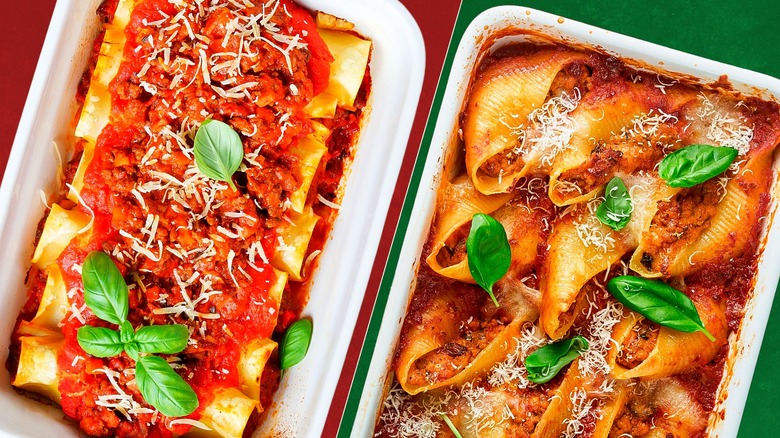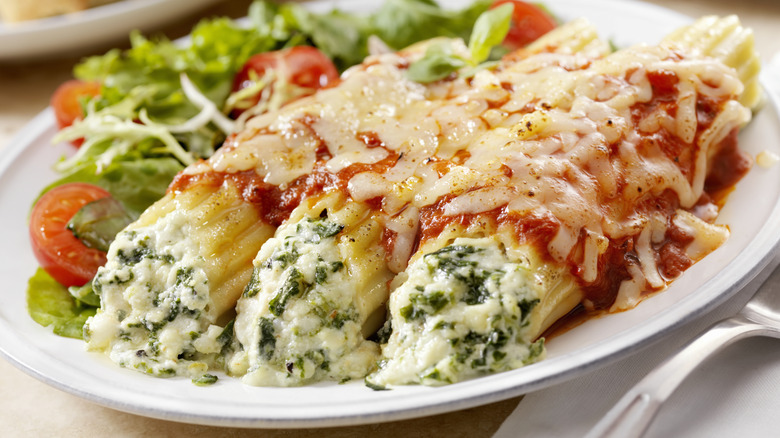Manicotti Vs Stuffed Shells: The Difference Between Filled Pastas
Crafting any stuffed pasta dish requires some degree of hands-on prep time. It's going to be more labor intensive than your go-to one-pot dinner or skillet meal, but for dimensional flavor and textural intrigue, we think it's well worth the extra labor of love. Stuffing pasta is also a great way to get kiddos involved in the kitchen! Today, we're zeroing-in on two of the most iconic filled pasta dishes foodies know and crave — manicotti and stuffed shells — and exploring what exactly makes these Italian-American comfort food classics different.
Manicotti is a classic Italian dish originating in the Campania region. It's sometimes also referred to as cannelloni, which translates to "big pipe" in Italian — a fitting title considering each manicotti tube boasts a cooked diameter of roughly one inch wide and four inches long. Stuffed shells, on the other hand, are not pipes; they're shells (surprise), and beyond being a pasta dish (which is inherently Italian), they don't share the deep traditional roots in Italian gastronomy that a dish like manicotti has.
But like manicotti, stuffed shells can lean simple with just cheese and tomato or be bulked up with ground sausage. Whichever one you prefer, these filled pasta dishes are both so impressive that no one will notice if you opt for a time-saving store-bought jarred pasta sauce instead of laboring over a special Sunday sauce. To serve, pair with a fresh green side salad and a basket of homemade garlic bread.
What is manicotti?
Classic manicotti is the poster child for rich comfort food with sophisticated flair. Large tubes of pasta are stuffed with cheese, covered in sauce, and baked in a casserole dish. Just slam it in the oven and let the gooey, melty magic happen. Manicotti is tube-shaped, ridged, and sliced on the bias, not unlike a larger penne. In fact, the word "manicotti" roughly translates to "sleeves" in Italian.
To make it, the pasta is boiled to a stiff al dente (one of our top manicotti tips), filled, and arranged in a casserole dish on top of a thick layer of tomato sauce. To garnish, the manicotti gets draped by a final layer of tomato sauce, more grated cheese, and fresh parsley, then baked until bubbly. Alternatively, some preparations stuff the pasta dry without parboiling it, instead adding extra water to the marinara sauce; but this method is less traditional.
Often, classic manicotti performs as an impressive vegetarian entree with just cheese, spinach, and tomato sauce. Manicotti is typically stuffed with some combination of ricotta cheese, eggs, and other cheeses (often shredded mozzarella and Parmesan). These roomy tubes can also be loaded with ground meat, herbs, and vegetables like mushrooms, onions, garlic, or sun-dried tomatoes. Some preparations swap the tomato sauce for Alfredo or pesto, and even seafood manicotti is a thing. It's highly customizable, but shy away from anything too avant-garde, or the taste and texture will veer unwelcomely far from the traditional profile of this classic dish.
What are stuffed shells?
On paper, stuffed shells follow a nearly identical prep to manicotti: Cook the pasta to al dente, fill, drape with tomato sauce, and bake. Also like manicotti, stuffed shells are commonly filled with a mixture of ricotta, eggs, herbs, other cheeses, and maybe some shredded wilted spinach. But to fit into the shells, filling variations are typically (but not always) physically smaller or softer, like cottage cheese or seafood salad. Instead, toothier ingredients like mushrooms or meats are often added to the tomato sauce and spooned over the stuffed shells as a hearty finisher, whereas in manicotti, the tomato sauce typically stays plain.
In stuffed shells, the filling is gently tucked into each shell using a small spoon. Once filled, the shells get cooked seam-side-up in a sauce-lined baking dish and topped with a final layer of sauce and cheese. Manicotti, on the other hand, is a tad trickier to fill. A pastry bag (or a zip-top bag with the corner snipped off) can be wildly helpful here. Pipe into one end of the pasta tube, then turn it and pipe into the other end.
Perhaps unsurprisingly, manicotti's denser profile comes with a tradeoff: Longer prep time. Manicotti requires roughly 30 minutes of hands-on prep and 50 to 70 minutes in the oven at 350 degrees Fahrenheit. Stuffed shells, by comparison, require just 15 minutes of prep time and bake in a 350 degrees Fahrenheit oven in 25 to 35 minutes, cutting both prep and cooking time in half.


